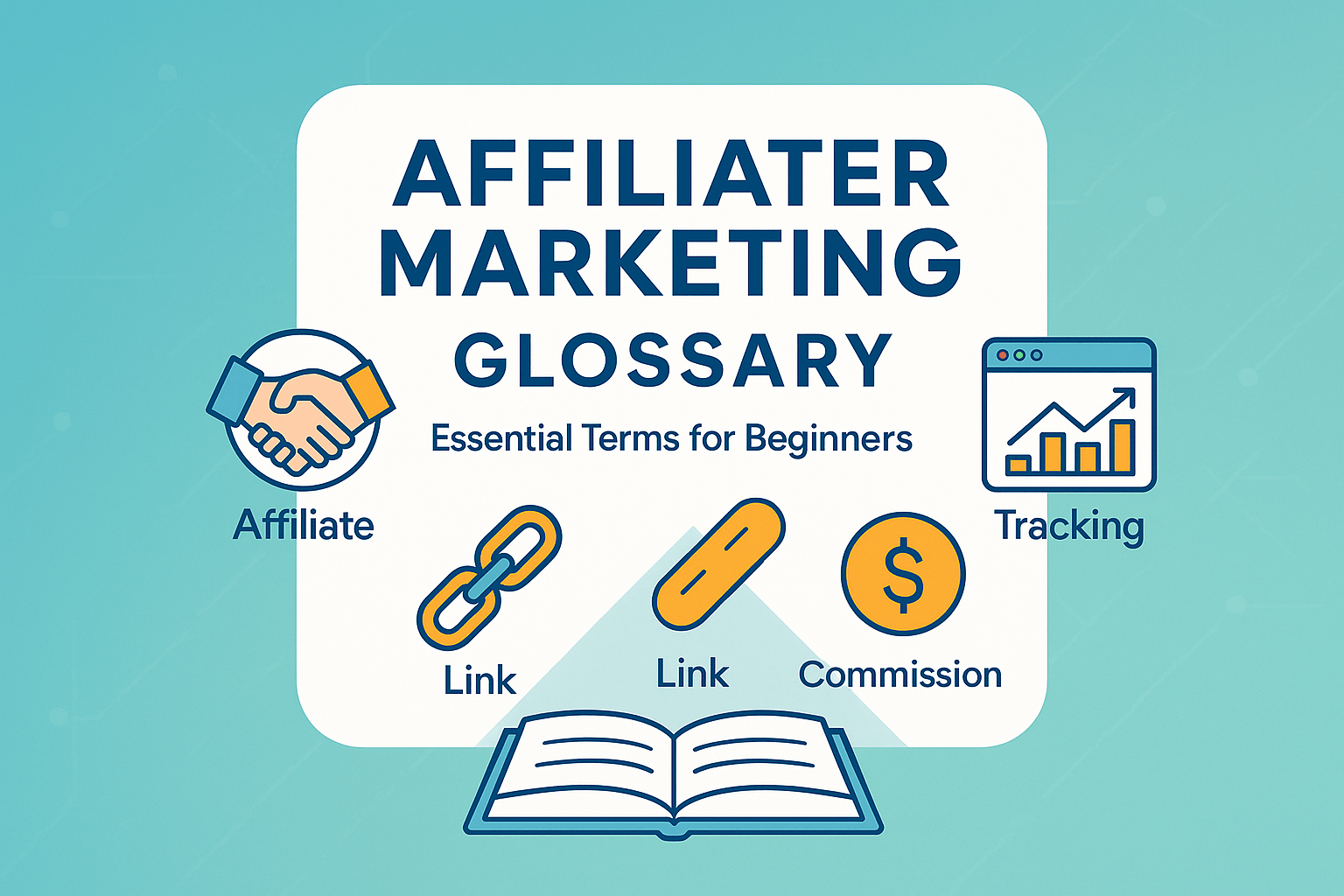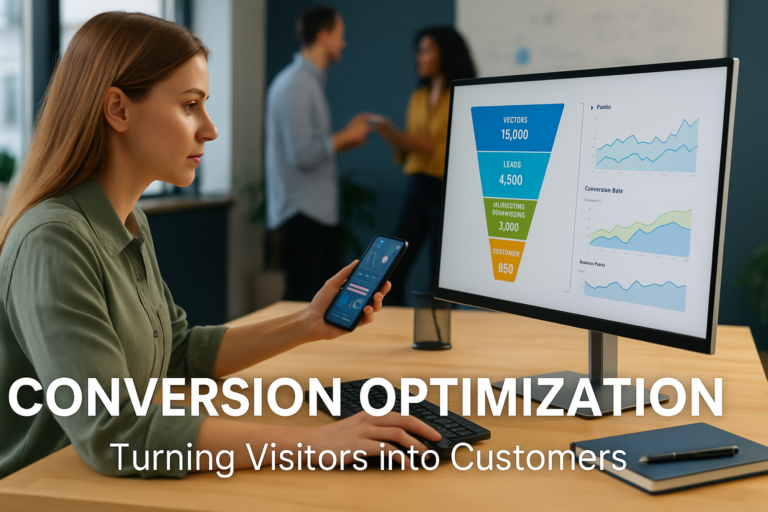Essential Terms in Affiliate Marketing: A Glossary for Beginners
Starting out in affiliate marketing can feel like a maze of terms you don’t understand. But don’t worry, this detailed glossary is here to help. With affiliate marketing now influencing 16% of US e-commerce transactions and spending projected to reach $12 billion in 2025, understanding these terms is more crucial than ever. (Source: Rewardful and Wix Blog industry statistics)
Key Takeaways
- Familiarize yourself with common affiliate marketing terms like CPA, CPS, and CPL.
- Understand the importance of affiliate links and how they help track sales and attribute commissions.
- Discover the different payment models and commission structures used in affiliate marketing.
- Learn about the role of cookies, impressions, and conversion rates in affiliate marketing analytics.
- Explore the various affiliate networks and platforms that connect advertisers and publishers.
Understanding the Basics of Affiliate Marketing
Affiliate marketing is a way for businesses to grow and sell more. It lets affiliates earn money by sharing products or services with their followers. Businesses give affiliates special links and materials to help track sales.
Affiliates can share products on many platforms like websites, social media, and emails. Success is measured by how many people buy, click, and how much money is made.
The affiliate marketing industry has experienced explosive growth globally. The market reached $18.5 billion in 2024 and is projected to grow to $31.7 billion by 2031, representing a compound annual growth rate (CAGR) of 8%. (Source: Cognitive Market Research, Hostinger 2025 Statistics). This shows how important affiliate marketing basics, commission rates, and good product promotion are.
Affiliate marketing helps build lasting customer loyalty. Affiliates who do well can earn money and build strong relationships with both the merchant and their followers.
“Affiliate marketing is a highly profitable and rapidly growing marketing channel that can expand the visibility of a company and drive traffic back to its website.”
Recent industry data shows Amazon Associates remains the dominant platform with nearly 95,000 companies using their network in 2025, representing 46.27% of the total affiliate marketing industry. (Source: Datanyze market analysis)
Good affiliate programs have clear goals, test and analyze, find new talent, and update offers often. By learning about affiliate marketing, businesses can use it to grow and meet their goals.
Essential Terms in Affiliate Marketing
Starting in affiliate marketing can feel overwhelming, especially for newbies. Let’s dive into some key affiliate marketing terminology, key concepts, and marketing lingo you need to know.
The core of affiliate marketing is the affiliate, or publisher. They promote products or services for an advertiser, the product owner. The affiliate gets a special affiliate link to track sales. They earn a commission for each sale or lead.
Cookie duration and attribution models are also important. Cookies track user activity. The cookie duration lets affiliates get credit for future sales. Attribution models decide who gets credit for a sale.
Affiliate networks connect advertisers with many affiliates. They handle payments, tracking, and reports. This makes working together easier for both sides.
| Term | Definition |
|---|---|
| Affiliate | An individual or entity that promotes products or services on behalf of an advertiser, earning a commission for any resulting conversions. |
| Advertiser | The product or service owner who partners with affiliates to promote their offerings. |
| Affiliate Link | A unique tracking code used to attribute conversions to a specific affiliate. |
| Conversion | The desired action taken by a user, such as a sale, lead, or sign-up, that results in a commission for the affiliate. |
| Commission | The fee or percentage paid to the affiliate for generating a successful conversion. |
| Cookie Duration | The length of time a user’s activity is tracked, determining how long an affiliate can receive credit for a conversion. |
| Attribution Model | The method used to assign credit for a conversion among multiple touchpoints or affiliates. |
| Affiliate Network | A platform that connects advertisers with a pool of affiliates, handling various aspects of the affiliate marketing ecosystem. |
Knowing these affiliate marketing terms and key concepts is crucial. It gives you a solid base to understand the industry. This knowledge can help you find success in affiliate marketing.
Common Commission Models and Payment Structures
In the world of affiliate marketing, how you get paid is key. It’s all about matching what merchants want with what affiliates can do. Let’s look at three main ways: Cost Per Action (CPA), Cost Per Sale (CPS), and Cost Per Lead (CPL).
Cost Per Action (CPA)
The Cost Per Action (CPA) model pays for actions like form submissions or email sign-ups. It’s great because it rewards affiliates for valuable interactions. This means they focus on getting quality leads and actions.
Cost Per Sale (CPS)
The Cost Per Sale (CPS) model, or Pay Per Sale (PPS), is a favorite. Affiliates get paid for each sale they help make. It’s a win-win because both sides profit from sales.
Cost Per Lead (CPL)
The Cost Per Lead (CPL) model pays for leads, like email sign-ups. It’s perfect for businesses wanting to grow their customer list. Affiliates aim to bring in serious leads.
There are more models like Cost Per Click (CPC) and Revenue Sharing (RevShare). Each offers a way to work together and meet goals. Knowing these models helps businesses and affiliates create strong partnerships.
| Commission Model | Description | Example |
|---|---|---|
| Cost Per Action (CPA) | Affiliates are paid for specific actions, such as form submissions or app downloads. | If a user signs up for a newsletter through an affiliate link, the affiliate earns a commission. |
| Cost Per Sale (CPS) | Affiliates earn a commission based on the number of successful sales they generate. | If a product sells for $50 and the commission rate is 10%, the affiliate earns $5 per sale. |
| Cost Per Lead (CPL) | Affiliates are compensated for generating qualified leads, such as email sign-ups or quote requests. | If an affiliate drives a user to submit a quote request, they earn a commission for that lead. |
Understanding these models helps businesses and affiliates find the best fit. This leads to successful partnerships that benefit everyone.
Emerging Affiliate Models
Affiliate marketing is evolving beyond traditional commission structures. New payment models are appearing that offer more flexibility and better rewards for high-performing affiliates. These emerging models often provide higher earning potential for affiliates who can deliver quality results.
Many top affiliate programs are experimenting with these newer approaches to attract and retain their best partners. Understanding these models can help you identify better opportunities and negotiate improved terms.
| Term | Definition |
| Hybrid Commission Structures | Payment models that combine multiple commission types, such as a base fee plus performance bonuses. This gives affiliates more predictable income while rewarding strong performance. |
| Performance Bonuses | Additional payments earned when affiliates exceed specific targets, like sales volume or conversion rates. These bonuses reward top performers and encourage consistent high-quality promotion. |
| Tiered Commission Rates | Commission structures that increase as affiliates reach higher sales levels. For example, 5% for the first 10 sales, 7% for sales 11-50, and 10% for sales beyond 50. |
| Subscription-Based Affiliates | Programs where affiliates earn ongoing commissions for as long as customers maintain their subscriptions. This creates recurring income streams for affiliates promoting software, memberships, or services. |
| Outcome-Based Partnerships | Advanced affiliate relationships where payment depends on specific business outcomes, like customer retention rates or lifetime value, rather than just initial sales. |
These new models show how affiliate marketing is becoming more sophisticated. While traditional pay-per-sale programs still work well, these emerging structures can offer better long-term earning potential for dedicated affiliates.
Understanding Tracking and Analytics
In the world of affiliate marketing, tracking and analytics are key to success. Tracking means watching affiliate link clicks and sales closely. Analytics tools give insights into important metrics like click-through rates and ROI.
Getting tracking right is vital for fair commission payments and improving your program. Without good tracking, it’s hard to know who’s bringing in the most value. Luckily, tools like Tapfiliate make tracking easy and rewarding.
With Chrome’s “decline cookies” option, tracking is changing. Third-party cookies were once key, but now we’re looking at server-to-server (S2S) tracking as a privacy-friendly option.
Analytics are essential for seeing how your affiliate program is doing. By watching conversion rates, you learn what works best. This helps you improve your program and boost earnings.
“Conversion matters. It tells you what works and what doesn’t for all affiliate types. It is the center of your entire program, strategy, and affiliate universe.”
As affiliate marketing changes, using tracking and analytics wisely is crucial. They help you make smart choices, improve your program, and increase your earnings.
Cookie Duration and Attribution
In affiliate marketing, cookies are key for tracking and attributing sales. First-party cookies, from the website itself, help pinpoint who gets the commission.
The cookie’s expiration date affects how long affiliates can earn commissions. While 30 days remains common, industry trends show a shift toward shorter durations (14-24 days) due to privacy regulations and browser changes. (Source: Current industry practices and privacy policy updates). This means affiliates can get paid if a customer buys something within that time after clicking their link.
Cookie Expiration Dates
Affiliate programs vary in their cookie policies. Some last just 24 hours, while others can last years. Longer cookies give affiliates more chances to earn from initial clicks, even if the sale takes time.
But, shorter cookies might push affiliates to make sales faster. They might use urgent offers to prompt quicker buys. Knowing the cookie policies of your programs is key to making more money.
Attribution Models
Affiliate programs also use different ways to figure out who gets the commission. The most common is last-click attribution. This means the affiliate who got the click right before the sale gets the commission.
Some programs, though, use more complex models like multi-touch or fractional attribution. These models split the commission based on each affiliate’s role in the sale. Knowing these models helps affiliates plan better to increase their earnings.
Understanding cookie duration and attribution models is crucial for affiliates. It helps them make better strategies and give great experiences to their audience. Keeping up with industry trends and program changes is vital for success in affiliate marketing.
Affiliate Links and Promotional Tools
Affiliate marketing is a strong way to boost sales and earnings. It relies on affiliate links and promotional tools. These links track who referred a sale, making sure affiliates get paid right.
Merchants give affiliates many tools to help them market. These include banners, text links, and product widgets. Some even offer email templates and social media content to help promote.
Using affiliate tracking links and promotional tools is key for affiliates to succeed. They help create engaging content that reaches the right people. This leads to more sales and higher earnings.
The mix of affiliate links and promotional tools is vital for success. It helps affiliates promote well, track results, and earn commissions that match their hard work.
Conversion Rates and Performance Metrics
In affiliate marketing, knowing key performance metrics is key to success. Two important ones are click-through rate (CTR) and conversion rate. CTR shows how many people click on your ads or links. A high CTR means your content and offers are hitting the mark with your audience.
Conversion rate shows how well your landing pages and calls-to-action work. Industry benchmarks show affiliate conversion rates typically range from 0.5% to 3%, with e-commerce averaging 2.3% in 2024. (Source: Current industry conversion benchmarks). Checking industry benchmarks helps you see how your program stacks up and where to improve.
Return on Investment (ROI)
Return on investment (ROI) is another key metric. It shows if your marketing is profitable. By watching your ROI, you can decide if your affiliate program is helping your business grow.
It’s also good to look at earnings per click (EPC), average order value (AOV), and customer lifetime value (CLV). These metrics give a full picture of your program’s success. They help you improve your strategies, find top partners, and keep customers coming back.
By keeping an eye on these metrics, you can make smart choices for your affiliate marketing. This can make your partnerships better and help your business grow over time.
Performance Marketing Metrics
Understanding performance metrics goes beyond basic conversion rates. Advanced metrics help you see the bigger picture of your affiliate marketing success. These measurements show not just if you’re making sales, but how valuable those customers are over time.
Smart affiliates track these deeper metrics to improve their strategies and focus on promoting products that bring the best long-term results. Many affiliate programs now share these advanced metrics with their top performers.
Several advanced metrics can help you understand your true affiliate marketing performance:
Customer Lifetime Value (CLV) measures how much money a customer will spend over their entire relationship with a business. For affiliates, this helps you understand which traffic sources bring the most valuable customers, not just the most sales. A customer who makes one $50 purchase might seem less valuable than one who makes a $100 purchase, but if the first customer returns to buy $200 more over the next year, they’re actually more valuable.
Blended Return on Ad Spend (ROAS) looks at your total return across all marketing channels, not just individual campaigns. This gives you a clearer picture of your overall profitability and helps you make better decisions about where to invest your time and money.
Multi-touch Attribution Metrics track all the different ways a customer interacted with your marketing before making a purchase. Instead of just crediting the last click, these metrics show the full customer journey. This helps you understand which content and touchpoints are most important for driving sales.
Cross-device Tracking follows customers as they move between their phone, tablet, and computer. Since many people research on mobile but buy on desktop, this tracking ensures you get credit for sales even when the purchase happens on a different device than the initial click.
Incremental Lift Measurement shows how much additional revenue your affiliate marketing generates compared to what would have happened without your efforts. This helps prove the real value of your marketing and can lead to better commission rates.
These advanced metrics require more sophisticated tracking, but they provide insights that can significantly improve your affiliate marketing results. Many successful affiliates use these measurements to negotiate better terms with merchants and focus their efforts on the most profitable opportunities.
Affiliate Networks and Platforms
The world of affiliate marketing is vast and complex. It has many networks and platforms to help businesses and marketers reach customers. Major affiliate networks like ShareASale, CJ Affiliate (15.8% market share), and Awin (30% of global publisher links) connect advertisers with affiliates across 180+ countries. (Source: Current market share data from industry reports). They offer services like tracking, reporting, and payment processing.
New marketing platforms are also appearing. They let businesses manage their own affiliate programs. Platforms like Rewardful work with payment processors like Stripe. They provide tools for managing programs.
| Affiliate Network | Market Share | Key Features |
|---|---|---|
| AWIN | 30% of publisher links worldwide | Operates in over 180 countries with 16,500+ advertisers and 200,000+ active publishers |
| CJ Affiliate | 15.8% market share | Trusted by twice as many IR500 brands as its nearest competition |
| Rakuten (formerly LinkShare) | 7.4% market share | Works with about 1,000 merchants and focuses on high-quality partnerships |
Choosing between affiliate networks and marketing platforms depends on your business needs. Networks offer a wide reach and established ecosystem. Platforms give more control and customization. Your choice should consider your budget, program complexity, and management level.
“Affiliate marketing is a mutually beneficial relationship where both the brand and the affiliate win.”
– Russell Brunson, Co-founder of ClickFunnels
Compliance and Legal Terms
In the world of affiliate marketing, knowing the legal rules is key for brands and affiliates. Following rules from the Federal Trade Commission (FTC) is vital. It helps keep things transparent and builds trust with people who buy things.
FTC Disclosure Requirements
The FTC requires affiliates to clearly disclose their financial relationships with advertisers. Updated December 2024 guidelines emphasize that disclosures must be ‘clear and conspicuous’ – meaning easily noticeable and understandable to the average consumer. (Source: FTC updated business guidance December 2024). Affiliates should clearly mark their posts as ads or include a big disclaimer on their site.
Affiliate Agreements
Affiliate agreements spell out the rules of the partnership between brands and affiliates. They cover things like how much money affiliates make, when they get paid, and how sales are tracked. It’s important for affiliates to know these rules to stay within the program’s limits.
Terms of Service
Terms of service tell affiliates what they can and can’t do in a program. They might talk about what kind of ads are allowed, who owns what, and who’s responsible for problems. Affiliates need to follow these rules to keep their partnership strong and legal.
| Key Compliance Considerations | Implications for Affiliates |
|---|---|
| FTC Disclosure Requirements | Clearly identify promotional content as such, often with “#ad” or a prominent disclaimer. |
| Affiliate Agreements | Review and adhere to the terms outlined in the agreement, including commission rates, payment schedules, and prohibited practices. |
| Terms of Service | Familiarize yourself with the program’s rules and guidelines, including restrictions on promotional methods and intellectual property rights. |
By following the law and sticking to their agreements, brands and affiliates can work well together. This helps everyone, including the people who buy things, and makes the whole affiliate marketing world better.

Privacy and Data Protection Terms
Privacy laws are changing how affiliate marketing works. New regulations mean affiliates need to be more careful about how they track users and collect data. Understanding these terms helps you stay compliant and keep your affiliate programs running smoothly.
Most affiliate networks are updating their tracking methods to work with these new privacy rules. This means better protection for users and clearer guidelines for affiliates.
| Term | Definition |
| GDPR Compliance | Following European privacy laws that require user consent before collecting personal data. Affiliates must ensure their tracking methods and data collection practices meet these standards. |
| Third-Party Cookie Deprecation | The phase-out of cookies that track users across different websites. This affects how affiliate links track conversions and requires new tracking solutions. |
| Server-to-Server (S2S) Tracking | A tracking method that sends data directly between servers instead of through user browsers. This provides more reliable tracking while respecting privacy settings. |
| Consent Management Platforms | Tools that help websites get proper user permission before using tracking cookies or collecting data. These platforms ensure affiliate tracking complies with privacy laws. |
| Privacy-First Attribution | Tracking methods designed to measure affiliate performance while protecting user privacy. These systems provide conversion data without exposing personal information. |
The good news is that most affiliate networks handle privacy compliance for you. Just make sure to follow their guidelines and keep your disclosures clear and visible.
Traffic Sources and Marketing Channels
In affiliate marketing, knowing about different traffic sources and marketing channels is key. Affiliates can use many ways to bring visitors to their sites and promote products. This includes organic search, paid ads, and more.
Organic search is a big player. Affiliates work to get their sites to show up higher in search results. They do this with SEO, like finding the right keywords and improving their site.
Paid ads are another way to get traffic fast. Platforms like Google Ads and Facebook Ads let affiliates target specific groups. This helps create brand awareness and drive sales.
Social media is also a big deal. Sites like Facebook, Instagram, LinkedIn, and Twitter help affiliates reach lots of people. They use influencer marketing, ads, and organic posts to connect with their audience.
Email marketing is great too. Affiliates build email lists and send out newsletters. This brings subscribers to their affiliate sites.
Content marketing, like blogs and videos, also attracts visitors. It’s a way to draw in people who are interested in what you’re talking about.
Mobile-specific sources, like push notifications, are important too. They help reach people on their phones, which is where most online activity happens.
It’s important for affiliates to keep track of how well their marketing is doing. They use tools to see what’s working and what’s not. This helps them make their marketing better.
“Diversifying your traffic sources is key to building a sustainable affiliate marketing business. By exploring a variety of channels, you can reach a broader audience and increase your chances of success.”
The world of affiliate marketing is always changing. To succeed, affiliates need to stay up-to-date and adapt. Using many different ways to get traffic helps them grow and make money in the long run.
Mobile Affiliate Marketing Terms
With mobile devices driving over 70% of affiliate marketing traffic, understanding mobile-specific terms is essential for success. Mobile affiliate marketing brings unique challenges and opportunities that require specialized knowledge and strategies.
Mobile users behave differently than desktop users. They often make quick decisions, have shorter attention spans, and expect seamless experiences. This has led to new tracking methods, optimization techniques, and promotional strategies designed specifically for mobile environments.
The shift toward mobile-first marketing has also created new compliance considerations and technical requirements. Understanding these mobile-focused terms will help you navigate the complexities of promoting affiliate products on smartphones and tablets.
Key Mobile Affiliate Marketing Terms
| Term | Definition |
| Mobile Attribution | The process of identifying which marketing touchpoints led to app installations, purchases, or other conversions on mobile devices. This is more complex than web attribution due to app store redirects and cross-device user behavior. |
| App Store Optimization (ASO) | The practice of optimizing mobile apps to rank higher in app store search results. For affiliates, this involves promoting apps that are well-optimized to increase conversion likelihood and maximize commissions. |
| Deep Linking | URLs that direct users to specific pages or content within a mobile app, rather than just opening the app’s homepage. Affiliates use deep links to create smoother user experiences and improve conversion rates. |
| Mobile Conversion Tracking | Specialized tracking methods designed to measure conversions on mobile devices, including in-app purchases, app installations, and mobile web conversions. This often requires different pixels and SDKs than desktop tracking. |
| In-App Affiliate Programs | Affiliate programs that operate entirely within mobile applications, allowing users to discover and purchase products without leaving the app environment. These programs often have unique commission structures and tracking requirements. |
| Mobile Attribution Window | The time period during which a mobile marketing touchpoint can be credited with a conversion. This is typically shorter than web attribution windows due to faster mobile user behavior patterns. |
| Cross-Device Tracking | Technology that connects user actions across multiple devices (phone, tablet, desktop) to provide a complete picture of the customer journey for attribution purposes. |
| Mobile Creative Formats | Specialized ad formats designed for mobile screens, including interstitial ads, banner ads, and video ads optimized for mobile viewing and interaction. |
Mobile affiliate marketing requires careful attention to user experience and technical implementation. The smaller screen sizes and touch-based interactions mean that traditional desktop strategies may not work effectively on mobile devices.
Success in mobile affiliate marketing often depends on choosing the right promotional methods for your audience and ensuring that affiliate links work seamlessly across different mobile browsers and apps. Many affiliates find that mobile users respond better to visual content and shorter, more direct calls-to-action.
Understanding mobile attribution is particularly important because the customer journey on mobile devices can be more complex. Users might see an ad on their phone but complete the purchase on their tablet or computer later. Proper attribution ensures that affiliates get credit for their role in driving these cross-device conversions.
Payment Methods and Thresholds
Affiliate marketing involves different payment methods and thresholds. Affiliates can choose from PayPal, bank transfers, store credit, and prepaid debit cards. Each option helps them get paid for their work.
Pay-per-sale is a common model. Affiliates earn a commission when a sale is made. For example, Walmart’s program offers 1% to 4% on most products. Some categories, like Contact Lenses, offer up to 18% commission.
Pay-per-lead rewards affiliates for leads. Gusto, a payroll software, pays $25 or more for each lead through their program.
The pay-per-call model rewards phone conversions. Service-based businesses like KGR Contractors use this model. They partner with networks like Invoca and RingPartner.
Affiliates need to know about payment thresholds and schedules. Some programs require a minimum before payout. Others pay monthly, quarterly, or annually to account for refunds or chargebacks.
| Payment Model | Example Merchants | Commission Rates |
|---|---|---|
| Pay-per-Sale | Walmart, Amazon | 1-4% (Walmart), 0-10% (Amazon) |
| Pay-per-Lead | Gusto | $25+ per lead |
| Pay-per-Call | KGR Contractors | Varies by merchant |
Understanding affiliate payments, payment thresholds, and commission payouts helps affiliates. They can make better choices and increase their earnings in affiliate marketing.
Advanced Marketing Terminology
Exploring affiliate marketing means learning key terms that boost our strategies. Terms like “above the fold,” “native advertising,” and “contextual marketing” are crucial. Let’s dive into these to improve our affiliate marketing.
Above the Fold
“Above the fold” is the top part of a webpage you see without scrolling. It’s key for grabbing attention and getting people to act. Making this area stand out can greatly help your marketing.
Native Advertising
Native ads blend in with the site’s content, offering a smooth user experience. They look like part of the site, not ads. Using native ads can build trust and engagement with your audience.
Contextual Marketing
Contextual marketing targets users based on what they’re doing online. It uses the site’s content to offer relevant affiliate links. This approach can lead to better results and a better user experience.
Other important terms like retargeting, A/B testing, and funnel optimization also matter. Keeping up with these can make your campaigns better, increase conversions, and boost your returns.

“The key to successful affiliate marketing is not just understanding the basic terms, but also embracing the more advanced concepts that can take your campaigns to the next level.” – John Doe, Affiliate Marketing Expert
AI and Automation in Affiliate Marketing
Artificial intelligence is changing how affiliate marketing works. Many platforms now use AI to help affiliates find better opportunities, optimize their campaigns, and earn more money. Understanding these AI-powered tools can give you an edge in the competitive affiliate marketing world.
AI helps solve common affiliate marketing challenges like finding the right products to promote, targeting the best audiences, and managing multiple campaigns at once. These technologies make it easier for affiliates to scale their efforts and improve their results without working more hours.
As AI becomes more common, knowing these terms will help you understand what different platforms and tools can do for your affiliate business.
Key AI and Automation Terms
| Term | Definition |
| Predictive Analytics | Technology that uses data to predict which products, audiences, or campaigns are most likely to succeed. This helps affiliates choose better opportunities and allocate their time and budget more effectively. |
| Automated Bidding | Systems that automatically adjust bid amounts for paid advertising campaigns based on performance data and goals. This saves time and often improves results compared to manual bidding. |
| AI-Powered Content Optimization | Tools that analyze content performance and suggest improvements to increase conversions. This might include optimizing headlines, calls-to-action, or even entire landing pages based on data. |
| Machine Learning Attribution | Advanced attribution models that use AI to better understand which marketing touchpoints deserve credit for conversions. This provides more accurate commission attribution than traditional methods. |
| Chatbot Affiliate Integration | Automated chat systems that can recommend affiliate products to website visitors based on their questions and preferences. These bots can generate affiliate sales 24/7 without human involvement. |
Many affiliate networks and tools now offer AI features built right in. You don’t need to be a tech expert to use them – most are designed to work automatically in the background. The key is understanding what these tools can do so you can choose the right ones for your goals.
AI tools are especially helpful for affiliates who promote multiple products or manage several campaigns at once. They can handle the repetitive tasks while you focus on strategy and relationship building.
Conclusion
In the world of affiliate marketing, knowing the key terms is essential for success. We’ve looked at a detailed glossary of important terms. This includes commission models, tracking methods, and compliance requirements. Keeping up with the latest trends and technologies is key for both affiliates and merchants.
By learning the affiliate marketing glossary and essential terms, we can handle the complex world of affiliate marketing with ease. We can improve our campaigns, analyze data, and follow rules. Mastering these basics will help us succeed in the long run.
Learning and being adaptable are crucial for success in affiliate marketing. As we grow our knowledge and try new strategies, we can reach the full potential of this powerful marketing tool. This leads to better engagement, more sales, and stronger partnerships between affiliates and merchants.
FAQ
Q1: What’s the difference between CPA, CPS, and CPL commission models? A: CPA (Cost Per Action) pays for specific actions like signups, CPS (Cost Per Sale) pays for completed purchases, and CPL (Cost Per Lead) pays for qualified leads. Choose based on your business goals and customer journey length.
Q2: How long do affiliate cookies typically last? A: Cookie duration varies widely, from 24 hours to several years. Most programs use 30-90 day cookies. Longer cookie periods benefit affiliates, while shorter periods encourage faster conversions.
Q3: What affiliate disclosure is required by the FTC? A: The FTC requires clear, conspicuous disclosure of affiliate relationships. Use phrases like “This post contains affiliate links” or “#ad” for social media. Disclosures must be easily visible and understandable to consumers.
Q4: What’s a good conversion rate for affiliate marketing? A: Conversion rates vary by industry, but typically range from 1-5%. E-commerce averages around 2.3%, while software and digital products may see higher rates. Focus on relevance and audience quality over volume.
Q5: Which attribution model is most common in affiliate marketing? A: Last-click attribution is most common, giving full credit to the final affiliate before conversion. However, multi-touch attribution is growing, especially for longer customer journeys.
Q6: What’s the minimum payout threshold for most affiliate programs? A: Minimum payouts typically range from $50-$100, though some programs offer lower thresholds ($25) or higher ones ($500+). PayPal and direct deposit are the most common payment methods.
Q7: Are affiliate links allowed on social media platforms? A: Most platforms allow affiliate links with proper disclosure, but policies vary. Always check platform-specific guidelines and use proper hashtags like #affiliate or #sponsored as required.
Q8: What’s the difference between an affiliate network and direct affiliate programs? A: Affiliate networks aggregate multiple merchant programs and handle tracking/payments, while direct programs are managed by individual companies. Networks offer convenience but may have higher fees.
Q9: How do I track affiliate marketing performance? A: Use analytics tools to monitor click-through rates, conversion rates, earnings per click (EPC), and return on investment (ROI). Most programs provide dashboards with detailed performance metrics.
Q10: What are the most profitable affiliate marketing niches in 2025? A: High-performing niches include finance/fintech, health and wellness, technology/software, education, and home improvement. Success depends more on audience quality and content relevance than niche selection.
Source Links
- https://www.cognitivemarket.com/affiliate-marketing-market-report/ – Global Affiliate Marketing Market Report 2024-2031
- https://www.hostinger.com/blog/affiliate-marketing-statistics/ – 45+ Affiliate Marketing Statistics for 2024
- https://blog.rewardful.com/affiliate-marketing-statistics – Essential Affiliate Marketing Statistics 2025
- https://www.wix.com/blog/affiliate-marketing-statistics – Affiliate Marketing Statistics: Industry Growth & Trends 2025
- https://www.publift.com/blog/affiliate-marketing-statistics – Affiliate Marketing Statistics 2025
- https://www.ftc.gov/business-guidance/resources/disclosures-101-social-media-influencers – FTC Disclosures 101 for Social Media Influencers (Updated December 2024)
- https://targetcircle.com/blog/affiliate-marketing/the-affiliate-marketing-dictionary/ – 35 essential affiliate marketing terms – Affiliate Glossary – Target Circle
- https://www.mobidea.com/academy/affiliate-marketing-glossary/ – The Essential Affiliate Marketing Glossary of Terms (2024 Update)
- https://mylead.global/en/blog/affiliate-glossary-essential-terms-in-affiliate-marketing – Affiliate glossary – essential terms in affiliate marketing
- https://www.bigcommerce.com/articles/ecommerce/affiliate-marketing/ – Affiliate Marketing 101: What it is and How to Get Started
- https://www.informaticsinc.com/blog/2016/affiliate-marketing-basic-concepts-explained – Key Affiliate Marketing Concepts & Strategies, Explained
- https://prettylinks.com/blog/affiliate-marketing-terms-2/ – The ABC’s of Affiliate Marketing (Terms You Need to Know)
- https://www.publisherdiscovery.com/resources/affiliate-glossary/ – The Ultimate Affiliate Marketing Glossary – Jargon Explained
- https://www.pushground.com/blog/affiliate-marketing-glossary-150-terms-and-jargon – Affiliate marketing glossary with the 150 must-know terms and jargon
- https://easyaffiliate.com/blog/affiliate-marketing-terms/ – 5 Affiliate Marketing Terms You Need to Know
- https://phonexa.com/blog/best-affiliate-commission-models/ – Exploring Affiliate Commission Models: A Comprehensive Guide – Phonexa
- https://bixgrow.com/commission-models-in-affiliate-marketing/ – Top 07 Common Commission Models in Affiliate Marketing
- https://www.flexoffers.com/blog/exploring-5-different-commission-structures-in-affiliate-marketing/ – Exploring 5 Different Commission Structures in Affiliate Marketing
- https://tapfiliate.com/blog/affiliate-marketing-tracking-methods/ – A Guide to Affiliate Marketing Tracking Methods – Blog – Tapfiliate
- https://www.partnero.com/articles/what-is-affiliate-tracking-a-beginners-guide-to-getting-started-2024 – What is Affiliate Tracking? A Beginner’s Guide to Getting Started (2024) | Partnero
- https://phonexa.com/blog/affiliate-marketing-metrics/ – 15 Essential Affiliate Marketing Metrics in 2024 – Phonexa
- https://www.craigcampbellseo.com/cookies-and-commissions-in-affiliate-marketing/ – Cookies and Commissions in Affiliate Marketing |
- https://vervologypartners.com/cookie-duration-in-affiliate-marketing/ – Understanding Cookie Duration in Affiliate Marketing
- https://betterlinks.io/affiliate-marketing-terms/ – 24 Important Affiliate Marketing Terms You Need to Know – BetterLinks
- https://www.crakrevenue.com/blog/affiliate-marketing-glossary/ – Affiliate Marketing Glossary: All the Essential Terms to Know | CrakRevenue
- https://skynethosting.net/blog/affiliate-marketing-terms/ – Top Essential Affiliate Marketing Terms you need to know in 2024
- https://partnerize.com/resources/blog/the-most-important-affiliate-marketing-kpis-for-successful-program-management – The 11 Most Important Affiliate Marketing KPIs for Successful Program Management | Partnerize
- https://www.growann.com/post/affiliate-marketing-metrics – 17 Affiliate Marketing Metrics & KPIs You Need to Measure
- https://tipalti.com/resources/learn/affiliate-network/ – The Complete Guide to Affiliate Networks for 2024
- https://adcumulus.com/blog/28-essential-affiliate-marketing-terms-know/ – 28 essential affiliate marketing terms you should know – AdCumulus
- https://tapfiliate.com/blog/affiliate-marketing-platforms/ – A Complete Guide to Affiliate Marketing Platforms – Blog – Tapfiliate
- https://www.termsfeed.com/blog/legal-agreements-affiliate-marketing/ – Legal Agreements for Affiliate Marketing – TermsFeed
- https://easyaffiliate.com/blog/set-out-terms-and-conditions/ – How to Set Terms and Conditions for Your Affiliate Marketing Program
- https://tapfiliate.com/blog/affiliate-agreement/ – Terms And Conditions to Include in Your Affiliate Agreement – Blog – Tapfiliate
- https://www.mobidea.com/academy/traffic-sources-affiliate-marketing/ – Best Traffic Sources for Affiliate Marketing (2024 Update)
- https://affise.com/blog/affiliate-traffic/ – Top Affiliate Marketing Traffic Sources for 2024
- https://www.amnavigator.com/blog/2019/02/18/affiliate-marketing-program-payments/ – How-To Guide to Affiliate Marketing Payment Terms, Methods, and Types – Affiliate Marketing Blog by Geno Prussakov
- https://tipalti.com/resources/learn/affiliate-payments/ – Affiliate Payments Guide: Payment Types and Solutions | Tipalti
- https://uppromote.com/blog/affiliate-payment-methods/ – Affiliate Payment: Definition, Methods & How to Pay Affiliates
- https://thirstyaffiliates.com/blog/affiliate-marketing-jargon-glossary-terms – Marketing Jargon: Affiliate Marketing Terms You Need to Know
- https://betterlinks.io/affiliate-marketing-jargon-you-need-to-know/ – 20+ Affiliate Marketing Jargon: Glossary of Terms You Need To Know – BetterLinks
- https://www.linkedin.com/pulse/ultimate-affiliate-marketing-glossary-key-terms-you-need-jahan-6q5ic – The Ultimate Affiliate Marketing Glossary: Key Terms You Need to Understand
- https://medium.com/@teamme/unlocking-the-world-of-affiliate-marketing-a-comprehensive-glossary-of-20-essential-terms-3ba8b945d0f2 – Unlocking the World of Affiliate Marketing: A Comprehensive Glossary of 20 Essential Terms
- https://thirdeyeblindproductions.com/the-basics-of-affiliate-marketing-key-terms-and-concepts/ – The Basics of Affiliate Marketing: Key Terms and Concepts
- https://www.kwanko.com/skale/blog/key-terms-in-affiliate-marketing-a-complete-guide-for-advertisers-and-publishers – Key Terms in Affiliate Marketing: A Complete Guide
- https://influencermarketinghub.com/affiliate-marketing-benchmark-report/ – Affiliate Marketing Benchmark Report 2025
- https://impact.com/partnership-marketing-study/ – Partnership Marketing Study 2024
- https://www.awin.com/gb/marketers/affiliate-marketing-report – Global Affiliate Marketing Report 2025
- https://blog.authorityhacker.com/affiliate-marketing-statistics/ – 136 Affiliate Marketing Statistics 2025







